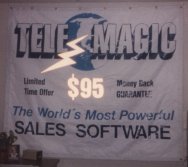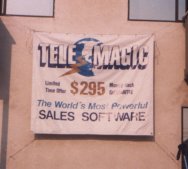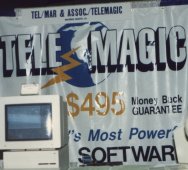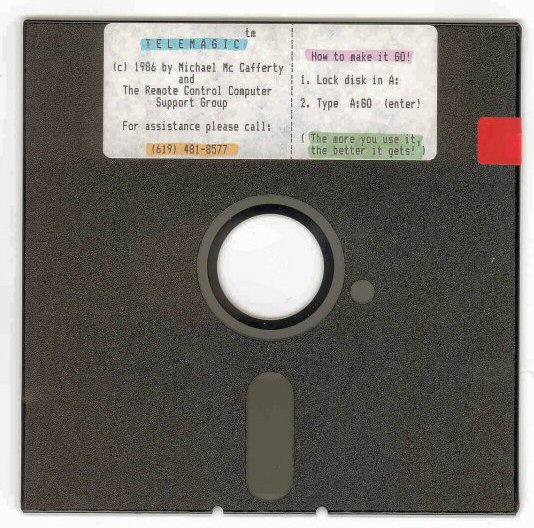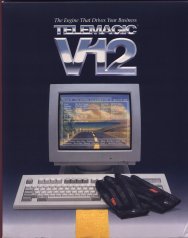
The TeleMagic Adventure"Software for Success in Business"
After the surprise ending of The PAL Adventure and the resulting total personal bankruptcy in 1983, I needed to start over from Scratch. I knew I would never be able to get a job that would pay enough for me to live at my former level and pay back all of the debts I put on hold by filing for the bankruptcy, but I applied at few places anyway. Once they found out I was the guy who invented PAL, they told me I was way too over qualified and that I would probably leave their employ as soon as I got my next Big Idea. They were right of course. Once you have experienced financial independence, it is difficult to return to working for The Man. So getting a job was out of the question. With no income, no credit cards, no savings, no car, and a growing hunger in my stomach, I needed to generate cash fast in order to eat. So I rented out my brain on an hourly basis to people who had computer problems. And of course, that's just about everyone who has a computer, so there were plenty of prospects. I did systems and applications custom programming on many different types of computers including Apple, CPM, PC-DOS, UNIX, IBM's mainframe DOS and OSMVT, minicomputers, and others. Within each different hardware/operating system, there were the many different variants of application programs such as communications, accounting, documents, spreadsheets, databases, backups, utilities, and the many variants of programming languages on each of the different systems. It was a non-stop high intensity intellectual challenge. I loved it. I was doing basically what I did in my early days with IBM, but I got to keep my individuality and freedom. One of the benefits of being an independent computer consultant is that you can get pretty creative. I could see that the Personal Computer as developed by IBM would be a big new opportunity for me so I started to specialize more on that system. Businesses were adopting it widely, and there were even portable computers that would soon be selling for less and eventually find their way into the homes of business people, and then ALL people. It was clear that the Personal Computer would be the new communications resource, replacing the telephone as the node of choice on the inevitably coming Global Network that I wanted to build in the PAL adventure. During this period I experimented with the early Bulletin Board Systems (BBS), and ran a free public Bulletin Board for a while, but the software was too limited to do what I had done with PAL and I just didn't have the heart to go down that road again so soon. I did this "hired gun programmer" gig for about two years, working for a couple of dozen regular customers who kept me hopping with various projects. As I got busier, I started specializing in business programming, and from there into sales analysis, and database manipulation.
TeleMagic Genesis More and more customers needed software that would help grow sales and process orders. Since I was a very successful salesman for IBM, I was familiar with the process of keeping records of my dealings with customers and prospects, and creating reports for management. I applied this knowledge to programming the solution for my customers using separate available products and getting them to work together. This was not the optimal solution, and so, in the Fullness of Time, and in early 1985, in my spare time, late at night and on weekends, after working full time doing computer consulting, I invented and programmed, in the Dbase II language for PC computers, the TeleMagic software product, and continuously improved it, solo, over the next several years, until I could eventually hire a programmer (Gary Bagheri) to help with the development. I saw the need for a software product for PCs that would be useful by salespeople and small businesses. It should maintain a database of customers and prospects, an "Electronic Rolodex" but with greatly increased functionality. The PC was a perfect power tool to replace the age-old shoe box with 3x5 cards that most salespeople used to keep track of their customers and prospects. Such a program did not exist at the time, and I saw that software focused on increasing sales would actually help sell more computers. The infant PC industry should really love it! I invented TeleMagic because I realized that by selling my brain on an hourly basis, even as interesting and rewarding as it was, and even though it paid the bills, it lacked Leverage and Continuity and Equity. If I wanted to play Frisbee on the beach instead of working, it was going to cost me money. What I really needed was a Product that I could employ Others to Sell and Support, on a Global basis, a product that could be used by All Businesses. A Product that would cost virtually Nothing for each additional copy created (only the cost of a diskette), and would therefore have a Wonderful Profit Margin, and whereby a virtually unlimited number of copies could be sold.I chose the company name Remote Control International because I liked the image of my company being controlled remotely, from the beach, while I was playing Frisbee thereupon. One of my first custom programming clients, Coffee Ambassador, an office coffee service in San Diego, needed software such as I had envisioned, and I proposed to the owner, Sean Curtis, that I would write the software he needed for $5,000 and that I would own it, and continue to develop it as a software product, sell it to others, and he would get upgrades at no cost. He agreed, as it was immaterial whether he owned the software, as long as he had the use of it, and it was a bonus to him to get fixes and upgrades for free. It was a true Win-Win. There are companies still using TeleMagic versions more than 25 years old because they just haven't found anything better. I really like that!
TeleMagic Early Days Of course, when I had the original idea for such a product, I was beset with the horrible demons of Self Doubt. Who am I to think that I can invent a new software product and compete with the likes of Microsoft and Lotus and Apple? They had millions of dollars to invest in such a product, I had only my spare time. They had huge distribution networks, I would have to start with nothing. They had a reputation. I was a nobody. The odds were enormously against me. As one simple example of this, I had no idea how to get the PC to dial a telephone, and yet that was one of the primary requirements for such a software product as I envisioned. Of course I solved the problem after a lot of research, but it was essential to success that I did not wait until I had all of the solutions before I started down the road. But one thing I learned, and refined, in the two years after my bankruptcy, is to focus on the day at hand, and the future takes care of itself. You can start down a Path, but must be detached from ever arriving at a Destination. So, I started down the road, one day at a time, each day writing a little more code, each day laughing at the impossibility of it all. And, soon enough, I finally had a prototype I could show a few prospects. The first stop was to show it to Coffee Ambassador, and they liked it a lot, except for the name of the product. A product name is a very important thing, and I was having a lot of difficulty coming up with a good one. When I showed it to Sean I had it named "Michael's Magical Money Machine". It was a double entendre in that the software was indeed a Money Machine for anyone who would use it in their business; it could easily double or triple sales very quickly. And, of course, if enough people bought the software, it would be a Money Machine for Michael too! Sean thought the name was a bit over the top. I thought it was fun, but went with his feedback, and then settled on another name I came up with: "TeleMagic". As you can see, I liked the idea of Magic in the name. This stemmed from one of my favorite quotes by Goethe:
Whatever you can do, or dream you can, Begin it. The "Tele" part of the name was from "telemarketing" or "telephone". The software was ideal for telemarketing salespeople, who needed to be highly productive, calling many people, making many presentations, and selling many accounts. In such an environment, the software would be a major advantage if it could cut down on paperwork, slice and dice the database to come up with the best calls to make, organize the follow up calls, enter orders, send letters, keep notes, etc. I focused on the telemarketing niche market at first because it was such a small, and yet highly identifiable marketplace, and I had experience with telephone selling from the PAL adventure. Another reason to focus on this niche was because there was a magazine for the industry ("TeleProfessional") that was located just a few blocks away. I showed them the software, and offered to install it free for them to use in their own business in exchange for a review article and reduced fees for advertising. For those of you who are reading this to get some ideas for success in business, I should stress very strongly that when you are starting with absolutely zero, you must focus very clearly on the Point of Greatest Leverage. The marketplace for a product like TeleMagic was enormous. Virtually everyone who used a computer needed a way to keep track of their customers and prospects. However, for me to advertise to this huge marketplace would be very expensive, way more than I had for even a small ad in PC Magazine. So I had to scale back my attack, and deal with a small section of the marketplace, the Sweet Spot that would pay off handsomely from a small investment. With the profits from the small, focused beginning I would have the resources to expand.
TeleMagic Pricing Theory Pricing is a black art, especially in the software business. I chose a very low introductory price of only $95 to motivate buyers to try this new product. It was low enough that anyone with a computer could afford it. Other telemarketing software products ran on large computers and the software was priced at tens or even hundreds of thousands of dollars. So, needless to say, TeleMagic raised a few eyebrows! Over the years, pricing was periodically adjusted upward, at the recommendation of our Authorized Marketing Partners, ("AMPs") to reflect increased functionality and demand. And every dollar of increased price fell to the bottom line as a dollar of increased profit. I remember thinking to myself what a wonderful business this was, that my dealers would actually recommend to me that I increase the price! But their logic was simple: the higher the price, the more profit they would make too because they were getting a 40% margin on the retail price. And they knew that they could sell it for more, so who was I to argue? The price went from $95 to $195 to $295 to $495 to $695 for a single user version. We found that there was very little price sensitivity until we reached the $695 price. Of course, the network version was more expensive, and was based on the number of users, and could run into several thousand dollars for a single installation of many users. TeleMagic went to the core of every business. It was a tool to generate more sales, to grow, to succeed. I created the tag line "Software For Success In Business" to describe the product. The tag line to describe the company was "Creating Excellence Essential to Our Customers' Success". In this case, we had two different customers: primarily the AMPs and ultimately the user of the software. We had a very clear self image, as a company, that the only way we could succeed is if we helped our customers succeed. One of my many primary personal responsibilities, (every entrepreneur must wear many hats) was the programming of new features and bug fixes, and I did all of this myself, all the way to version 10, and when the business could afford it, we were lucky enough to get help from Gary Bagheri, the technical genius who did all the tricky stuff that made the product work reliably. We made an excellent product development team!
Reasons for TeleMagic Success Soon after the introduction of TeleMagic, the market became flooded with "me too" products, and the genre was dubbed "Contact Management" software, and later on it morphed into "Sales Automation" and "Customer Relationship Management" (CRM), but TeleMagic was unique for several reasons: First of all, it was Simple: Easy to Learn, and Easy to Use. This was a big benefit for people who were just becoming familiar with computers. The reason why I programmed TeleMagic to be so Simple is because of my background as an entrepreneur and a salesman. I knew salespeople didn't want to spend a lot of time learning something new, and I knew that business owners didn't want to spend a lot of money training new people. If they didn't "Get It" right away, they wouldn't Buy It right away. They had to look at the first screen and say to themselves "I can do this!". Competitive products were designed by Programmers, who seemed to always want to show off how clever they were, and left the users confused. The best software is written by ego-less programmers who can truly listen to and deliver what the customer needs, not what the programmer wants to do. Second, the software was sold through a network of Authorized Marketing Partners (AMPs) who would install the software and train the end users, and continue to support the product and sell upgrades. This was a big key to our success. Other products were advertised heavily in trade publications, and sold "retail" with no local support options. Third, the program was designed from the outset to be easy to customize and to integrate with other software products, especially word processors and accounting systems. Competing products like Act! and SaleMaker and GoldMine would take years to do this. Fourth, we offered a Developer's Kit, which allowed others to build Add-on products to TeleMagic, to extend and customize its capabilities for specific vertical markets or individual custom needs. One of the most successful of these Add-ons was "Broker Magic" for stock brokers, done by our top-selling AMP Jeff Multz. These "Add-On" products could be priced at whatever the market would bear, and in one case of note, one of our dealers was getting more than $5,000 for a single user version of TeleMagic simply because it had been enhanced with recruiting industry specific fields and help files. No other product offered such a powerful way to make money. The Developers' Kit was a major competitive advantage for TeleMagic, and for the dealers. Fifth, our in-house salesreps and support personnel worked hard to help our AMPs succeed. We knew that we could not succeed unless our AMPs were successful. We published a detailed "Business Plan for Success" that showed how to do marketing and sales and demonstrations of the product. We were not selling TeleMagic software as much as we were selling a Business Opportunity for AMPs. An integral part of the Business Plan for Success was Michael Gerber's excellent book "The E-Myth: Why Most Small Businesses Don't Work, and What To Do About It". Other software companies simply tried to push dealers to sell more of their software, but we trained and motivated our AMPs and took a sincere interest in their success. We built Systems for Success in Business. TeleMagic became the number one selling sales automation software product in the world, due in large measure to our dedicated Team Members, the many talented AMPs who loved, sold, supported, and wrote Add-ons for the product, and the hundreds of thousands of customers who used the software to dramatically improve their sales and customer service, and then became "raving fans" of the product and told their friends.
TeleMagic Wins Inc. 500 Awards
The company grew rapidly in sales and profits and was among the
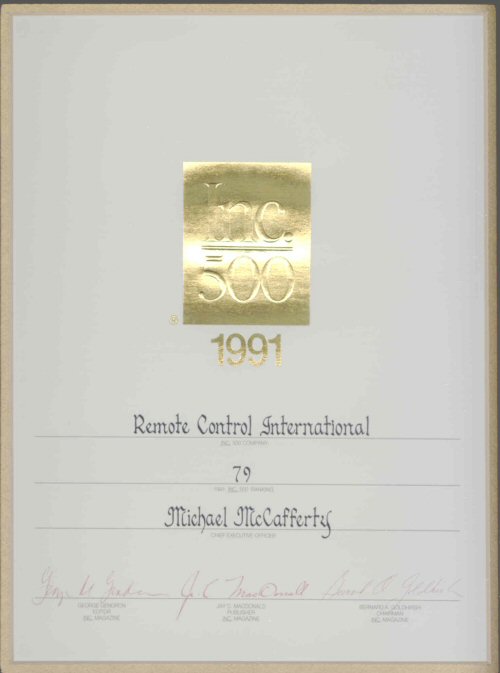 The Inc.500 award for 1991. Also received award for 1992. (click to enlarge)
TeleMagic Purchased By Sage Group On October 2, 1992 my company, Remote Control International, was purchased by Sage Group Plc. (Newcastle-Upon-Tyne, England). The deal was brokered by Corum Group, ("the premier provider of M&A services to software and information technology companies worldwide"). I was very fortunate to have Bruce Milne, Corum's founder, to work with me personally. After Sage (now Best Software in the USA) took control, they installed a series of new managers and never invested the money for marketing and product development that they promised, and the company went steadily down hill until they formally withdrew further development and support for the product at the end of 2003. However, TeleMagic licenses are still being sold by Best software, and support continues to be available from many loyal developers, dealers, trainers, etc.
TeleMagic Summary One of the most interesting and pleasurable things about the entire TeleMagic adventure was the enthusiasm and appreciation expressed by the many people who used the software that I invented and programmed into existence and worked hard to build. It felt good to know I was Helping Others. And it felt immensely good that I had finally completed the alchemy of turning dreams into dollars, and the resulting financial independence.
There are at least two books containing chapters that partly chronicle the TeleMagic adventure:
What you Say Is What You Get
The Greatest Sales Stories Ever Told,
from The World's Greatest Salespeople
The TeleMagic Team
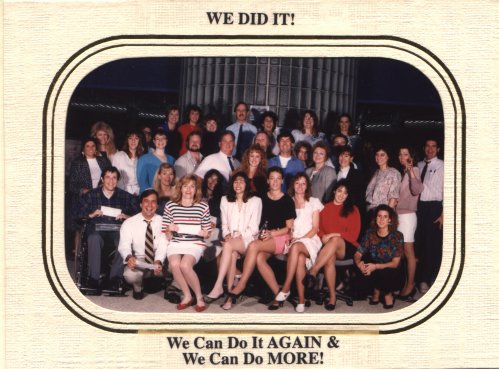
(click to enlarge) We were a great team! We had a corporate philosophy, almost a mantra, of "continuous improvement". Japanese businesses call this concept "kaizen", but I hadn't heard of it at the time, and I'm sure they never heard of me. Here our small group of believers and achievers display bonus checks after blasting past seemingly impossible sales goals. Each time we doubled our previous best, everyone in the company received checks for double the previous bonus! When Sage Group bought the company, we had 70 highly motivated Team Members.
Exhibited internationally for the first time in Rotterdam, Netherlands, the source code was licensed to resellers in Canada, U.K., Ireland, France, Switzerland, Netherlands, Australia, South Africa, Singapore, Sweden, and Russia.
Comdex trade shows were fun opportunities to meet new friends!
The Version 12 product packaging was our best.
Above is an early "packaged" version of TeleMagic. Notice the label created with a dot matrix printer
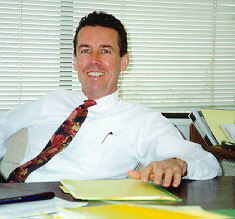
The True Story of How and When CRM Was Invented
Michael McCafferty: Adventures in Business
|
